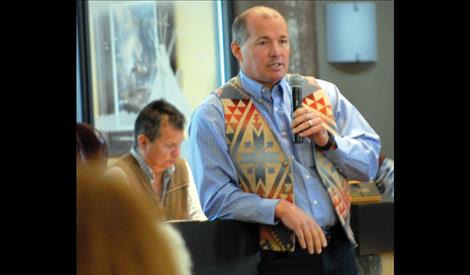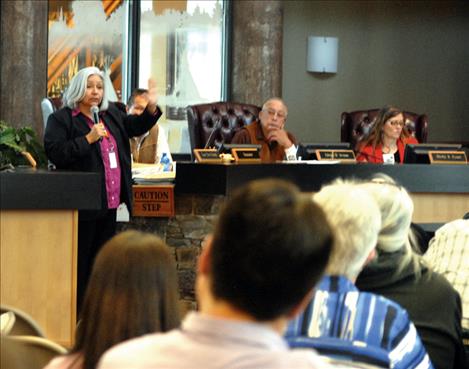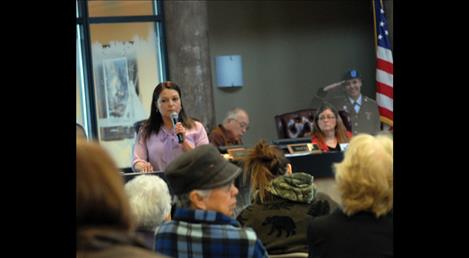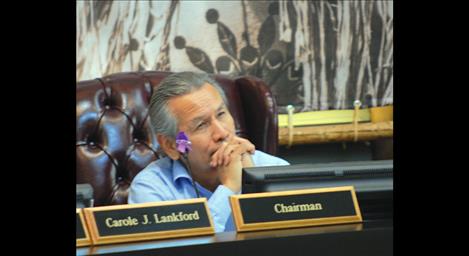Water Compact, meth, more discussed at tribal quarterly meeting
Hey savvy news reader! Thanks for choosing local.
You are now reading
2 of 3 free articles.
The Water Compact and methamphetamine abuse cropped up many times at the Confederated Salish and Kootenai Tribes quarterly meeting on April 3.
CSKT attorney Rhonda Swaney updated the membership on the progress of the Water Compact. It has passed through the Montana Senate and is now in the Montana House of Representatives Judiciary committee, she said. On April 11, comments will start at 10 a.m. The proponents speak first and then the opponents, according to Swaney.
“Please, those of you who can come, come,” she said, adding a special invitation to Elder Pat Pierre, who “saw us through all those contentious meetings.”
Councilperson Shelly Fyant said the sheer number of proponents will count and urged people to get on the bus.
The Water Compact will need 51 votes for approval, Swaney said, and the latest count is 58 votes.
“It’s going be very close,” she said. “There are going to be a lot of dirty tricks pulled, mostly by the Republicans. This is our last chance to get the Water Compact through the Legislature.”
The CSKT will be providing transportation to Helena. Compact proponent Mary Stranahan also arranged transportation. Contact Rob McDonald at 675-2700, ext. 1222, or robertmc@cskt.org
Swaney said the CSKT has always taken the high road.
“I’m very proud of our people for doing so,” she said.
Reporting on Community Strong, council people Shelly Fyant and Patty Stevens brought up meth and the toll it’s taking on the community. Community Strong is a large group of tribal employees and interested tribal members who are concerned about the substance abuse issue. They have a strategic plan, according to Fyant, but Tribal Council hasn’t approved it.
Fyant set up two meth awareness meetings in March. At the first one, Tribal Law Enforcement Captain Louis Fiddler and Officer/Drug Task Force agent Vern Fisher spoke to approximately 50 people about meth use and what it looks like. Another presenter was a former addict, who’s been clean for four years.
At the second meeting on March 17, Jason Adams from CSKT Housing talked about the meth testing they do for housing units. A meth remediation contractor gave an overview of what that entails.
The group developed an action plan, and the officers gave out their phone numbers so people can turn in suspected users or places where meth is being made. Another part of the action plan was the bottleneck at the Montana State Crime Laboratory in Missoula. Tribal Law Enforcement has 90 cases pending testing. Stevens researched the problem and found that Montana House Bill 512 is winding its way through the legislature. That bill would establish another crime lab in Eastern Montana.
Since the evidence isn’t there to prosecute meth users, they walk. There aren’t readily available treatment options or counseling, and there is increased youth involvement, according to Stevens. She said grandparents are raising children. The Tribal Council has been discussing across the board drug testing.
“The ultimate goal is to get at the heart of abuse. All this abuse is a symptom of a larger problem,” Stevens said.
Stevens and Fyant said they couldn’t do the job so they’re advocating for funding for a Community Strong coordinator, who can work full time at prevention, education, enforcement, treatment and aftercare.
Tribal member Curtis Morigeau asked if the tribe had put any money aside to work on the meth problem instead of millions put aside for a casino.
Donna Orr agreed. She said put he casino aside and put the money in law enforcement and the addiction centers we need.
“The problem is more than just throwing money at it; it’s assessing the problem and what the appropriate responses would be,” Tribal Council Chair Vernon Finley said. “We made it our priority. We’ll find the money for whatever we decide is the appropriate approach.”
He said he discusses the meth problem during the current issues portion of education presentations he gives about the tribes.
“When I get to current issues, I say, ‘Meth is kicking our butt,’” Finley said.
He’s presented to international groups — people from China, South America, Europe, Australia — and says they will speak up to say it’s their number one issue as well.
“It’s not just us, not just Montana, not just the United States; it’s a universal problem,” Finley said.
“… Do not assume that we (Tribal Council) don’t see it and that it isn’t something that we carry with us. Our people and the health of our tribe — it’s critical,” he added. “It’s on our minds and in our hearts every day; don’t ever assume it’s not.”
Finley steered the meeting back to the agenda, and Carolee Wenderoth, CSKT Lands Department, reported on the land buy back program. She said wave two of the program is slated for fall 2015. The national buyback staff was on the Flathead Reservation in the fall of 2014. Offers to fractionated properties in the amount of $8.1 million went out then, with $5.2 million completed. The team should be here again between April and July.
A question from the tribal members present was: what happens to the monies when the land buy back is over, does that money go into a scholarship fund, and is there a specific time period?
Wenderoth said funds from the Cobell settlement are available over a 10-year time frame. The monies stay in the United States Treasury.
“Everything that is unspent goes back to the U.S. Treasury,” Wenderoth said.
She added that of the $60 million generated through purchases, a portion of each sale goes into the scholarship pot, resulting in about $5 million in the fund.
“Although we know (the scholarship fund) is out there hanging, we don’t know when or even who can apply,” Wenderoth said.
The buy back staff should be sending out information soon.
Wenderoth then outlined what’s happening with the Gray Wolf Casino.
“There have been many questions,” she said, including issues about law enforcement and who will respond to the casino, public safety, and the turnouts off the highway.
An environmental assessment is currently underway.
The news got out before the planning schedule on the Gray Wolf update, she said, and there are many levels of approval.
The project increases the boundary of the business lease because of the inclusion of the gravel pit, and that’s what triggered another environmental assessment on the soil, water, wildlife, endangered species and cultural sensitivity. There have been three previous environment assessments, beginning with the one for U.S. Highway 93 expansion, and there have been “a finding of no significant impact,” each time, Wenderoth said.
Those previous studies will be on the website as well as gaming studies, because they are trying to be as transparent as possible.
“Our goal as a (Tribal Lands) department is to protect the resources for the 10 that are sitting up there,” Wenderoth said, gesturing to Tribal Council. “Our department is here to protect the resources of the Flathead Reservation.”
She made it clear that after experts in environment assessments had made their findings, and the Lands Department had done their due diligence, by law there is a 30-day comment period and “then individuals will have a chance to have their say.”
Brian Lipscomb, president and CEO of Energy Keepers, Inc., reminded tribal members there are 154 days left before the CSKT take control of Kerr Dam.
The Tribal Council will soon be sending information to tribal members so they can submit ideas for names for the dam.
Energy Keepers is also looking for broader opportunities to market the power, Lipscomb said.
When quizzed by CSKT tribal members about the projected income of the dam, he estimated the dam will produce approximately 1.1 million megawatt hours, or about $25 million, “although that’s greatly dependent on natural gas.”
Lipscomb said EKI will have long term and short term contracts in place.
“We will be looking at structuring up to 75 percent (of the power); the rest will be real time, sold through a consulting group in Washington,” he said.
He had no answer about what Kerr Dam would do to the per capita paid out, saying that was a conversation to be had with Tribal Council.
Terry Tanner asked what EKI’s role would be, since it was established to purchase Kerr Dam. Lipscomb answered that EKI would operate the dam, maintain it into the future and market the power.
“Will it be transparent?” Tanner asked.
EKI will produce an annual operations plan, adopted by the membership and ratified by the CSKT Tribal Council.
“It won’t be a public document, but it will be available to tribal members,” Lipscomb explained.
Head of Tribal Health Kevin Howlett talked about his department. Under his leadership, Tribal Health now has five clinics, employs 160 people and generates $7 million in yearly revenue — “a far cry from where we were,” Howlett said.
He spoke about drugs and the necessity for a treatment center.
“Drug addiction is personal to me,” he said. “I lost my mother and lost two brothers.
Howlett asked, “How are we going to support a treatment center?”
He estimated that conservatively, it would take $75 to $100 million.
“When we talk about meth, we’re talking about the effects of something. What’s causing this kind of situation — no hope, no education, no job. We can’t, we shouldn’t just spend our energy on the effects. What’s causing it?” he said.
Fyant had questions for Howlett.
She’d heard from a lot of tribal members who don’t use Tribal Health facilities because of lack of confidentiality.
“I take confidentiality very seriously. If they violate it, I’m going to fire them. There’s no excuse; it’s a federal violation,” Howlett responded.
Another issue was tribal members near Arlee would prefer the services of a doctor to a new building, Fyant said.
“In terms of a doctor versus a new building, why not both?” Howlett answered, explaining that they are not in the business of remodeling old buildings and many tribal members come from Missoula to Arlee for services.
During public comment, tribal member Marian Andrew, who identified herself as a full-fledged gambler, said she chose to speak in the form of a letter “cause I tend to get emotional.”
She read the letter, saying she didn’t want to contradict or take personal issue with anyone.
“I prayed and prayed,” she said.
She grew up gambling and finds herself fully addicted with no control. She urged the council “to look at what gambling is doing to our people. The saddest part is our children — going without clothes, food, time with their parents. … Who’s going to be the spokesman for these kids while their parents are gambling at a casino?”
Although she praised Finley’s article in the Char-Koosta about gaming bringing economic independence, she said she believes there has to be a better way than a casino, suggesting expanding schools for Indian students with Indian teachers, a retirement haven for the elders, not a rest home because “a rest home is very, very depressing.”
Elder Steven Small Salmon spoke about “talking Indian,” and Nkusm, the Salish immersion school where he and elder Pat Pierre teach.
Other public comments included ideas for a better place for a casino, underfunded programs, whether or not KwaTaqNuk Resort and Casino is in the black, if the idea of a casino should go to a vote of the tribal membership and purchasing daily recreation permits.



















